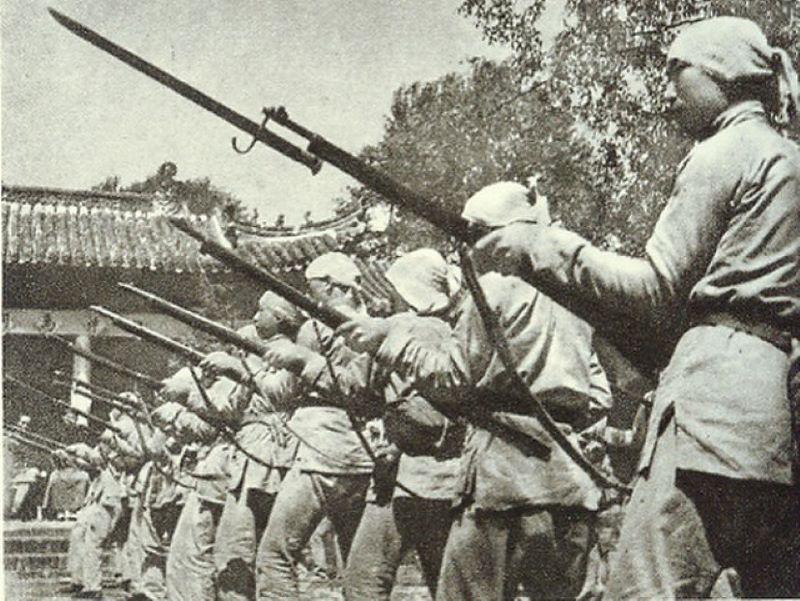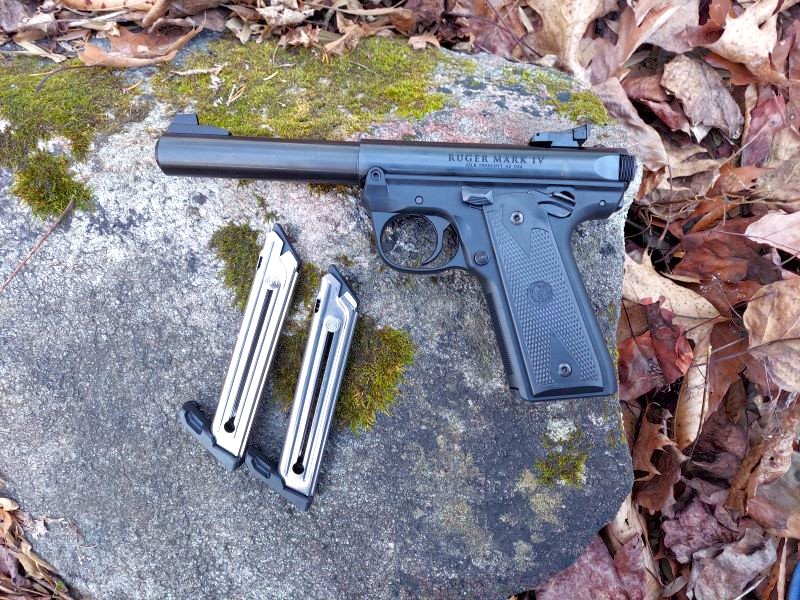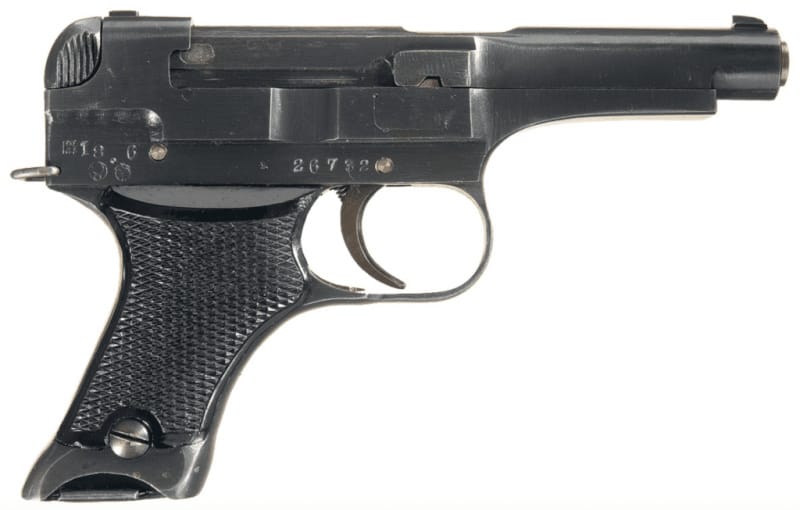Japan is a nation famous for her cars and electronics. Although firearms seldom come to mind, Japan does have a small, but prestigious arms industry. In fact, Browning and Winchester have produced their rifles and shotguns at the Miroku plant for decades.

The West first encountered Japanese firearms on a mass scale when Imperial Japan’s oriental blitzkrieg swept through Asia and the Pacific Rim during the Second World War. That first impression was mixed at best and partly the result of equipment bias and partly by design.
America came into World War II with the autoloading M1 Garand rifle and submachine guns like the Thompson. By comparison, Japan was still fielding the bolt action Arisaka rifle, and their only submachine gun, the Type 100, was produced in very small numbers. Imperial handguns also left something to be desired compared to the Colts and Smith & Wessons carried by the GIs. The Nambu series of handguns were considered underpowered, ugly, and downright dangerous to the user.
Indeed, from the plum-shaped bolt handle on the Arisaka to the ungainly appearance of the Type 94 Nambu, Japanese guns were considered ugly and their inferiority was inferred. But post-war, attitudes changed. While the Japanese small arms of World War II still would not win a beauty contest, the robustness of their designs began to be appreciated, if not outright copied. Here are four common Imperial service arms that, for better or worse, left a lasting impression.

The Type 38 Arisaka
Japan at the turn of the 20th century was an emerging industrial powerhouse and noted naval power. Like all other nations, Japan had its share of technical savants. In arms design, Imperial Army Major Kijiro Nambu was, for all intents and purposes, the John Browning of Japan.
John Browning did not necessarily invent the first of every category, but he made it practical and available. Likewise, Major Nambu took an existing design and gave it an overhaul. Japan entered the 20th century with a relatively modern bolt action infantry rifle in the Type 30. It was loosely modeled on the Model 1893 Spanish Mauser and chambered in a flat and soft-shooting 6.5x50mm cartridge. It had a flush-fit magazine and could be rapidly loaded with five-round stripper clips. But what existed on the parade ground often failed to meet expectations on the killing ground.
The Model 30 soldiered through the Russo-Japanese War successfully, but the bolt mechanism, similar to that of the older German 1888 Commission rifle, was deemed too fragile. Even before the war finished, Major Nambu headed a government commission to improve or replace the Type 30. The resulting Type 38 was introduced in 1905. It retained the same 6.5mm cartridge and Mauser-like lines of the Type 30, but it was given a new push-in manual safety, a solid bolthead, and a large claw extractor. In essence, the Type 38 bolt became Mauser-like. Over 3.5 million Type 38 long rifles and cavalry carbines would be produced before production ceased in favor of the more powerful Type 99 rifle in the early 1940s.
The Type 38 served Japan through the Great War. Some were even given as war aid to Thailand, Britain, and White Russia during the Russian Civil War. But by the time of the Second World War, the circa-1890s era concept of the long rifle was out of date. In the 1930s, Europe had been convinced that long-range volley-fire and massed cavalry charges were a thing of the past and made moves towards a universal short rifle. Rifles like the German Kar. 98, the Italian M38 Carcano, and the French MAS 36 define the type. By comparison, the Type 38 was lengthy. Without the attached sword bayonet, the Type 38 was 50 inches in length. The average height of the Japanese infantryman at the time was 64 inches.
Length was not the only feature with potential for criticism. On the American side, the Type 38 was derided as ungainly and loud. American servicemen were particularly critical of the Type 38’s dust cover. The dust cover was an improvement over the Type 30 that shrouds the bolt body so that mud and grit do not get into the action. But the dust cover reportedly had a tendency to rattle, giving away the position of Japanese soldiers in combat. But in truth, the dust cover makes no noise when the action is closed. There is only a rattle when the action is being worked, which is difficult to do in silence no matter the rifle.
Despite these criticisms, the Type 38 in the original 6.5×50 round is an easy rifle to shoot. Felt recoil is mild and muzzle flash is low compared to the 30-06 and .303 caliber rifles fielded by the Western allies. Although the Type 38 was built with a smaller receiver ring than competing post-1898 Mausers, the rifle’s action is deceptively strong. Post-war, the famous wildcatter PO Ackley converted a number of Arisakas for his high-pressure .270 Magnum cartridge. He attempted and failed to destroy the action. He had no such trouble with more desirable actions like on the Mauser and Enfield rifles.
The Type 99 Arisaka
Imperial Japan’s campaigns in China carried on for 14 years and, in many ways, mirrored Nazi Germany’s war of annihilation against the Soviet Union. Over 20 million Chinese were killed, the majority of which were civilians. Although China’s internal divisions had the nation weak and unable to respond to the Japanese invasion of Manchuria in 1931, by the time Japan crossed into China proper in 1937 the calculus had changed. Chiang Kai Shek had nominally brought the nation’s warlords under him. Despite Japan’s advantages at sea and in the air, the war on the ground soon drew to a stalemate by 1940 and casualties within the Imperial Army mounted.

As the war grew more unwinnable, field reports on the inadequacies of the Type 38 rifle stacked up. The rifle’s 6.5mm cartridge, in particular, was found lacking in hitting power. The Chinese fielded Mauser-pattern rifles firing the 8mm Mauser round, which hit harder and could punch through barriers decisively. These events likely intersected with the Japanese experience in climactic street fighting in large cities like the Battle of Shanghai in 1937. One could speculate that the long length of the Type 38 that fit the mold in open battle became a liability in close, desperate fighting. The 6.5×50 round was also found lacking in machine guns. At extreme ranges, it was harder to use the smaller 6.5 machine guns in Japanese service as an area-denial weapon. The Chinese 8mm Maxim guns could suppress Japanese formations from further away with greater authority.
The Japanese Army tried to bridge the gap by introducing new machine guns in a 7.7mm round. But having two different types of ammunition made for a logistical nightmare. Japan needed a new rifle and it was found in the Type 99.
The Type 99 rifle was introduced in 1939. It chambered the 7.7x58mm cartridge and was built on an enlarged Type 38 action. The new rifle was originally produced as a long rifle, but a short-pattern rifle soon became the standard. In terms of size, the Type 99 is a pound lighter and six inches shorter than the Type 38. The new 7.7 round used a 182 grain .30 caliber bullet and was comparable to the rounds fielded by the Chinese and their Western Allies.
This rifle proved to be handier and more capable than the Type 38. It came with a number of interesting add-ons early in the Pacific War. The rifle was initially fielded with a dust cover, a wire monopod, and a rear sight with anti-aircraft wings. It is also arguably the first rifle to have a chrome-lined bore from the factory to prevent corrosion. The Type 99 was simplified further as the war went on and the final versions of the rifle skipped the accessories and unnecessary millwork entirely. About 3.5 million of these rifles were made when production ceased after the surrender of Japan in 1945.
Post-war, Julian Hatcher tested the Type 99’s action and found it as indestructible as Ackley found the Type 38. Although the bolt gun was outmoded as an infantryman’s tool, chrome lining has since become a cherished feature for shooters since.
The Nambu 14 Pistol
Imperial Japan was interested early in the autoloading pistol, but came late to the table when it came to military adoption. Kijiro Nambu, yes that Kijiro Nambu, borrowed heavily from the designs of the turn of the century like the C96 Broomhandle Mauser to produce Japan’s first domestic semi-auto — the Nambu pistol. The new pistol was out in 1902. The Swiss adopted the first military-issue semi-auto pistol in the form of the Luger, only two years previously. It would be another 10 years before the United States went the autoloader route and more before Britain and France would follow suit.

Japanese officers were required to purchase their own handguns and could, more or less, get away with whatever handgun they wanted. Some carried the then-issue Type 26 revolver. Others carried Western pistols like the Browning 1900 or Colt 1903. The Nambu became an option, but it was not officially endorsed as a replacement for the Type 26 until 1926. That form of Nambu was termed the Type 14.
In terms of style, the Type 14 is Luger-like and has a grip angle close to 60 degrees. The pistol is recoil operated and has an exposed barrel that reciprocates part-way with the bolt, just like a C96. The bolt was enlarged and knurled at the rear to enable to user to cock the pistol. The Type 14 held eight rounds of 8×22 Nambu. The round is a .32 caliber bottlenecked pistol cartridge that propelled a 100-grain bullet at 1000 feet per second. In terms of power, it was better than the .32 and .380 ACP pistols in present use in Europe, but not on par with the 9mm Luger or 45 ACP.
Over 400,000 Type 14 pistols were produced by Imperial Japan. Although later commenters would go on to claim that the Type 14 pistol is underpowered and prone to weakening recoil and striker springs, this is likely due to a combination of weak ammunition and elderly firearms. Whether that commentary is valid or not, the design did not go unnoticed. Type 14 Nambu bring-backs after the war influenced Bill Ruger’s Standard .22 auto pistol. The Standard went on to become one of the most popular .22 pistols made today. Likewise, manufacturers have since been necking down existing pistol cartridges to get higher velocity. The short-lived .32 NAA pocket pistol round bears strikingly similar characteristics to the old 8×22 Nambu load.

The Type 94 Pistol
The Type 14 Nambu is the most prolific Japanese handgun of World War II, but it could not be produced in large enough numbers to meet demand. The Nambu was also a large handgun that was a nuisance to carry. Kijiro Nambu emerged from retirement to develop a new, smaller handgun for officers, tank crewmen, and the like. Nambu’s last design was adopted by the Imperial Japanese Army as the Type 94 pistol in 1934.

The Type 94 was more compact than the Nambu and came in at half the price. This was a boon for junior officers on a tight salary. Outside of being smaller and cheaper, the Type 94 is a bit more modern looking. It looks like a slide-actuated handgun from afar, but mechanically, it used a similar C96-style recoil-operated bolt. The Type 94 also had a concealed hammer, instead of the Type 14’s striker-fired design. The new pistol held six rounds of the same 8x22mm Nambu ammunition.
The Type 94 sold well, but it never eclipsed the Type 14 in production, with an estimated 71,000 units produced by the time the Second World War ended in 1945. The Type 94 was controversial, even in its day, for its ability to discharge without pulling the trigger. The pistol had an exposed trigger bar. The bar links the trigger with the sear that drops the hammer. If depressed with the manual safety disengaged, the pistol can discharge. This unfortunate feature has earned the Type 94 the reputation as one of the worst handguns of the war. But given the standard practice of carrying handguns with no loaded chamber, the chances of a mishap when carrying are minimized.
Parting Shots
We are approaching 80 years since the end of the Second World War in the Pacific. The reputation of the guns of Imperial Japan have come full circle since then. Although odd to the eye, these more rugged attributes of these shooting irons have since been partially rehabilitated. It can still be tempting to look at your kit and then the enemy’s kit, and say, “No wonder they lost.”
While gear selection can turn engagements, it is ultimately a small issue when it comes to winning a war. In truth, war in 1941 was imminent and attacking Pearl Harbor was Imperial Japan’s only shot. If the United States could not be intimidated into reopening trade by a single show of force, Japan would be put into a defensive war without the oil and steel to win it.
While Japanese small arms could not win or lose the war, the exploits of those who carried Arisakas and Nambus into battle, became a propaganda tool that did. Despite the odds against them, Japanese ground forces enjoyed initial successes over greater adversaries in their sweep through Southeast Asia in 1942. These successes and Japan’s latent racism convinced every man from general to private that an aggressive spirit could trump weaker-willed opponents with better equipment. These exploits against long odds strengthened a fatal illusion that the war could always be fought to a favorable outcome. That illusion invited the deaths of millions and the beginning of the nuclear age.

